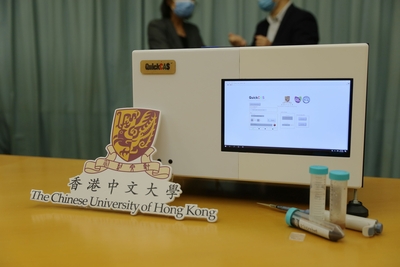Microrobotic detection system diagnoses infectious pathogens

Researchers from The Chinese University of Hong Kong (CUHK) have developed a fully automated, low-cost and rapid microrobotic diagnostic system with comparable sensitivity and specificity to clinical detection methods. The research team is now studying the application of this microrobotic system for multiple pathogens, including the virus that causes COVID-19.
As the COVID-19 pandemic rages worldwide, the soaring demand for rapid testing has led to heavy workload for laboratory personnel on an unprecedented scale. Prompt clinical diagnosis is critical for patients showing signs of suspected infection, but under the dual pressure of pandemic and existing medical needs, shortages of medical manpower and resources may delay diagnosis.
Professor Li Zhang and his team have now developed an innovative microrobotic detection system, integrating the novel fluorescent microrobots with an external magnetic actuation system to accurately detect specific pathogens in a short time. The microrobotic sensing probes are G. lucidum spores coated by a layer of iron oxide nanoparticles and functionalised with carbon dots. By analysing the changes in the fluorescence signal of the microrobots under green light excitation, the system can determine the presence of pathogen in patients’ samples. In addition, the system uses an external magnetic field to remotely actuate the microrobots, speeding up the fluorescence quenching and thus shortening the detection time.

The first generation of microrobotic detection system, ‘QuickCAS’, was built to detect Clostridium difficile (C. diff) — a common pathogen of nosocomial infection. The research team is now entering clinical trials, with the goal of testing in hospitals next year. The team has also worked closely with Professor Margaret Ip in utilising the microrobotic detection system for COVID-19 diagnosis. Efforts to detect multiple pathogens using the microrobotic detection system are underway, covering common pathogens such as Streptococcus pneumoniae, Salmonella, pathogenic Escherichia coli and Helicobacter pylori.
Current chemical detection methods rely on the reaction between pathogen and biomolecular reagents. These bioreagents typically need to be refrigerated or frozen to preserve their structure and viability. By contrast, the microrobots are stable for transportation and storage under room temperature. Additionally, existing methods of C. diff detection take 2–4 hours, but QuickCAS only takes 15–30 minutes to complete, and the cost has been reduced from approximately HK$300 ($50) to about HK$50 (AU$8) per test.

“As QuickCAS uses physical detection methods, the reagents do not require refrigeration,” Prof Zhang said. “It successfully breaks through the pain points of current chemical detection methods. In the future, medical centres in remote and poor areas or small-scale healthcare service providers will have the opportunity to provide accurate clinical diagnostic services.”
Not only will the automated system provide hospitals with timely diagnosis and treatment for patients, it should also reduce the workload and the risk of infection of medical staff during laboratory tests. Moreover, infection controls can be implemented earlier to prevent infection outbreaks. By simplifying the testing procedures, even junior laboratory technicians with only basic training can operate the system, alleviating the pressure from experienced laboratory technicians.
Please follow us and share on Twitter and Facebook. You can also subscribe for FREE to our weekly newsletters and bimonthly magazine.
SEQ koala population carries immunity to retrovirus
Koalas from a population north of the Brisbane River appear to have evolved a unique genomic...
RSV immunisation program for babies slashes hospital stays
An Australian-first study has demonstrated the effectiveness of immunisation against respiratory...
A targeted treatment option for psoriasis
New research from MedUni Vienna paves the way for the development of a therapy that not only...




